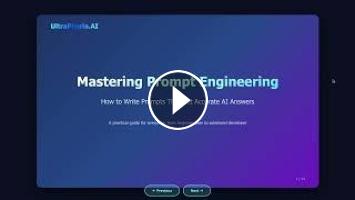#promptengineering #chatgptcourse #aiprompts #aiengineering #aicourses #howtousechatgpt
## ???? How to Write Prompts To Get Accurate AI Answers: A Practical Guide to Mastering Prompt Engineering
https://ultraphoria.ai/articles/prompt-engineering-deck
This practice is known as **Prompt Engineering**. Whether you're drafting an email, writing code, or researching a complex topic, mastering the art of the prompt is the key to unlocking accurate, relevant, and high-quality AI answers.
Here is a practical, step-by-step guide to help you master prompt engineering and get the best results from any AI.
### Step 1: Define the **Role** and **Goal**
The AI often performs best when it understands *who* it is and *what* it needs to achieve.
* **Assign a Role (Persona):** Tell the AI to act as an expert in the field relevant to your query. This sets the context and influences its tone, vocabulary, and approach.
* **Example:** *“Act as a **senior software engineer** specializing in Python.”* or *“You are a **professional copywriter** crafting compelling ad copy.”*
* **State the Clear Goal:** What is the desired output? Be specific about the action the AI should take.
* **Bad Goal:** *“Tell me about climate change.”*
* **Good Goal:** *“**Summarize** the three main causes of sea-level rise and **list** actionable steps a homeowner can take to reduce their carbon footprint.”*
### Step 2: Provide **Context** and **Constraints**
Context is the *who, what, when, and where* of your request. Constraints are the boundaries the AI must operate within.
* **Supply Necessary Background:** If the AI needs to reference specific information (a previous conversation, a document, or a scenario), include it directly in the prompt or refer to it explicitly.
* **Example:** *“Based on the attached business plan, **write an executive summary** focusing only on the Q3 revenue projections.”*
* **Set Constraints on Format, Length, and Style:** Direct the AI on *how* the answer should look.
* **Format:** *“Present the information as a **Markdown table**.”* or *“Structure the answer as a **five-paragraph essay**.”*
* **Length:** *“The summary must be no more than **200 words**.”* or *“Provide **three distinct examples**.”*
* **Tone/Style:** *“Use a **formal, academic** tone.”* or *“Write in a **fun, casual** style suitable for a social media post.”*
---
### Step 3: Implement **Instructional Clarity**
Ambiguous instructions lead to ambiguous results. Use clear language, strong verbs, and logical structures.
* **Use Strong Verbs:** Instead of vague terms, use action-oriented verbs: **Analyze, Compare, Contrast, List, Explain, Evaluate, Translate, Refactor, Categorize.**
* **Specify Exclusion/Inclusion:** Clearly state what the AI *should* and *should not* do.
* **Example:** *“**Do not** use jargon. **Include** a definition for any technical terms you must use.”*
* **Use Delimiters for Data:** When inputting a large block of text, code, or data, use delimiters like triple quotes (`"""..."""`), tags, or square brackets to clearly separate the input data from the instructions. This helps the AI isolate the information it needs to process.
* **Example:** *“Summarize the core argument in the text below. The summary must be under 75 words.*
*`"""[Input Text Here]"""`*
* **Iterative Prompting (Refinement):** If the first answer isn't perfect, don't start over! Use the current output and ask the AI to **refine** it.
* **Refinement Prompt:** *“That’s good, but make the tone more enthusiastic and add a call to action at the end.”*
---
### Step 4: Validate and **Test** Your Prompts
Prompt engineering is not a one-and-done process; it requires testing and iteration.
* **Test on Different Models:** If you have access, try the same prompt on different AI models (or different versions of the same model). Their underlying training data and architectures can yield varying results.
* **A/B Test Instructions:** Try two slightly different prompts to see which one delivers a more accurate or useful response. For instance, does "Write a summary" work better than "Condense the main points"?
* **Check for Hallucinations:** Always **verify** factual information, especially dates, statistics, and specific citations, as LLMs can sometimes confidently generate false information (known as "hallucinations").
---
### ???? The Prompt Engineering Checklist
Before you hit 'Send', run through this quick checklist:
| Element | Check | Example |
| **Role** | Is an expert persona assigned? | *Act as a financial analyst...* |
| **Goal** | Is the desired action clear? | *...create a detailed projection.* |
| **Context** | Is all necessary background included? | *...based on the last 5 years of data.* |
| **Constraints** | Are format, length, and style defined? | *...in a bulleted list, maximum 150 words, using a formal tone.* |
| **Clarity** | Are the instructions unambiguous? | *Do not include external links.* |
## ???? How to Write Prompts To Get Accurate AI Answers: A Practical Guide to Mastering Prompt Engineering
https://ultraphoria.ai/articles/prompt-engineering-deck
This practice is known as **Prompt Engineering**. Whether you're drafting an email, writing code, or researching a complex topic, mastering the art of the prompt is the key to unlocking accurate, relevant, and high-quality AI answers.
Here is a practical, step-by-step guide to help you master prompt engineering and get the best results from any AI.
### Step 1: Define the **Role** and **Goal**
The AI often performs best when it understands *who* it is and *what* it needs to achieve.
* **Assign a Role (Persona):** Tell the AI to act as an expert in the field relevant to your query. This sets the context and influences its tone, vocabulary, and approach.
* **Example:** *“Act as a **senior software engineer** specializing in Python.”* or *“You are a **professional copywriter** crafting compelling ad copy.”*
* **State the Clear Goal:** What is the desired output? Be specific about the action the AI should take.
* **Bad Goal:** *“Tell me about climate change.”*
* **Good Goal:** *“**Summarize** the three main causes of sea-level rise and **list** actionable steps a homeowner can take to reduce their carbon footprint.”*
### Step 2: Provide **Context** and **Constraints**
Context is the *who, what, when, and where* of your request. Constraints are the boundaries the AI must operate within.
* **Supply Necessary Background:** If the AI needs to reference specific information (a previous conversation, a document, or a scenario), include it directly in the prompt or refer to it explicitly.
* **Example:** *“Based on the attached business plan, **write an executive summary** focusing only on the Q3 revenue projections.”*
* **Set Constraints on Format, Length, and Style:** Direct the AI on *how* the answer should look.
* **Format:** *“Present the information as a **Markdown table**.”* or *“Structure the answer as a **five-paragraph essay**.”*
* **Length:** *“The summary must be no more than **200 words**.”* or *“Provide **three distinct examples**.”*
* **Tone/Style:** *“Use a **formal, academic** tone.”* or *“Write in a **fun, casual** style suitable for a social media post.”*
---
### Step 3: Implement **Instructional Clarity**
Ambiguous instructions lead to ambiguous results. Use clear language, strong verbs, and logical structures.
* **Use Strong Verbs:** Instead of vague terms, use action-oriented verbs: **Analyze, Compare, Contrast, List, Explain, Evaluate, Translate, Refactor, Categorize.**
* **Specify Exclusion/Inclusion:** Clearly state what the AI *should* and *should not* do.
* **Example:** *“**Do not** use jargon. **Include** a definition for any technical terms you must use.”*
* **Use Delimiters for Data:** When inputting a large block of text, code, or data, use delimiters like triple quotes (`"""..."""`), tags, or square brackets to clearly separate the input data from the instructions. This helps the AI isolate the information it needs to process.
* **Example:** *“Summarize the core argument in the text below. The summary must be under 75 words.*
*`"""[Input Text Here]"""`*
* **Iterative Prompting (Refinement):** If the first answer isn't perfect, don't start over! Use the current output and ask the AI to **refine** it.
* **Refinement Prompt:** *“That’s good, but make the tone more enthusiastic and add a call to action at the end.”*
---
### Step 4: Validate and **Test** Your Prompts
Prompt engineering is not a one-and-done process; it requires testing and iteration.
* **Test on Different Models:** If you have access, try the same prompt on different AI models (or different versions of the same model). Their underlying training data and architectures can yield varying results.
* **A/B Test Instructions:** Try two slightly different prompts to see which one delivers a more accurate or useful response. For instance, does "Write a summary" work better than "Condense the main points"?
* **Check for Hallucinations:** Always **verify** factual information, especially dates, statistics, and specific citations, as LLMs can sometimes confidently generate false information (known as "hallucinations").
---
### ???? The Prompt Engineering Checklist
Before you hit 'Send', run through this quick checklist:
| Element | Check | Example |
| **Role** | Is an expert persona assigned? | *Act as a financial analyst...* |
| **Goal** | Is the desired action clear? | *...create a detailed projection.* |
| **Context** | Is all necessary background included? | *...based on the last 5 years of data.* |
| **Constraints** | Are format, length, and style defined? | *...in a bulleted list, maximum 150 words, using a formal tone.* |
| **Clarity** | Are the instructions unambiguous? | *Do not include external links.* |
- Catégories
- prompts ia
- Mots-clés
- prompt engineering, chatgpt, aiprompt














Commentaires